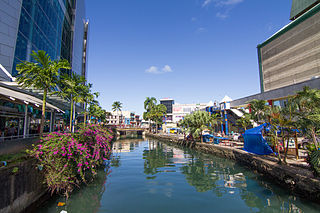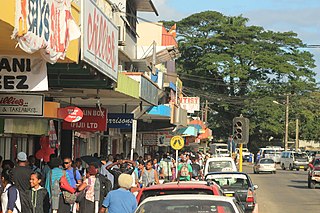
Fiji, officially the Republic of Fiji, is an island country in Melanesia, part of Oceania in the South Pacific Ocean. It lies about 1,100 nautical miles north-northeast of New Zealand. Fiji consists of an archipelago of more than 330 islands—of which about 110 are permanently inhabited—and more than 500 islets, amounting to a total land area of about 18,300 square kilometres (7,100 sq mi). The most outlying island group is Ono-i-Lau. About 87% of the total population of 924,610 live on the two major islands, Viti Levu and Vanua Levu. About three-quarters of Fijians live on Viti Levu's coasts: either in the capital city of Suva; or in smaller urban centres such as Nadi—where tourism is the major local industry; or in Lautoka, where the sugar-cane industry is dominant. The interior of Viti Levu is sparsely inhabited because of its terrain.

The demographic characteristics of the population of Fiji are known through censuses, usually conducted in ten-year intervals, and has been analysed by statistical bureaus since the 1880s. The Fijian Bureau of Statistics (FBOS) has performed this task since 1996, the first enumerated Fiji census when an independent country. The 2017 census found that the permanent population of Fiji was 884,887, compared to 837,271 in the 2007 census. The population density at the time in 2007 was 45.8 inhabitants per square kilometre, and the overall life expectancy in Fiji was 67 years. Since the 1930s the population of Fiji has increased at a rate of 1.1% per year. Since the 1950s, Fiji's birth rate has continuously exceeded its death rate. The population is dominated by the 15–64 age segment. The median age of the population was 27.9, and the gender ratio of the total population was 1.03 males per 1 female.

The economy of Fiji is one of the most developed among the Pacific islands. Nevertheless, Fiji is a developing country endowed with forest, mineral and fish resources. The country has a large agriculture sector heavily based on subsistence agriculture. Sugar exports and the tourism industry are the main sources of foreign exchange. There are also light manufacturing and mining sectors.

The population of Australia is estimated to be 26,659,000 as of 31 July 2023. Australia is the 55th most populous country in the world and the most populous Oceanian country. Its population is concentrated mainly in urban areas, particularly on the Eastern, South Eastern and Southern seaboards, and is expected to exceed 30 million by 2029.
Fijians are a nation and ethnic group native to Fiji, who speak Fijian and share a common history and culture.

Nausori is a town in Fiji. It had a population of 57,866 at the 2017 census. This makes it the fourth most populous municipality in the country. Situated 19 kilometers outside of Suva, it forms one pole of the burgeoning Suva-Nausori corridor. Nausori is home to three provinces Rewa, Tailevu and Naitasiri.

Hinduism in Fiji has a following primarily among Indo-Fijians, the descendants of indentured workers brought to Fiji by the British as cheap labor for colonial sugarcane plantations. Hindus started arriving in Fiji starting in 1879 and continuing through 1920, when Britain abolished the slavery-like indenture system. Fiji identifies people as "Indo-Fijians" if they can trace their ancestry to the Indian subcontinent, Hindus form about 27.9% the population of Fiji.

Most of the 25-30 million followers of Sikhism, the world's fifth-largest religion, live in the northern Indian state of Punjab, the only Sikh-majority administrative division on Earth, but Sikh communities exist on every inhabited continent. Sizeable Sikh populations in countries across the world exist in India (20,833,116), Canada (771,790), England (520,092), Italy (220,000), Australia (210,400), and the United States (~200,000), while countries with the largest proportions of Sikhs include Canada (2.12%), India (1.56%), Cyprus (1.1%) England (0.92%), New Zealand (0.87%), and Australia (0.83%).

As of July 2023, holders of a United States passport may travel to 184 countries and territories without a travel visa, or with a visa on arrival. The United States passport currently ranks eighth in terms of travel freedom, according to the Henley Passport Index. It is also ranked 4th by the Global Passport Power Rank.

Visa requirements for Chinese citizens are administrative entry restrictions imposed on citizens of China by the authorities of other states.

Visa requirements for British citizens are administrative entry restrictions by the authorities of other states placed on citizens of the United Kingdom. As of 18 July 2023 British citizens had visa-free or visa on arrival access to 188 countries and territories, ranking their passport 4th in terms of travel freedom according to the Henley Passport Index. Additionally, the World Tourism Organisation also published a report on 15 January 2016 ranking the passport 1st in the world in terms of travel freedom, with the mobility index of 160.

Visitors to Fiji must obtain a visa from one of the Fijian diplomatic missions unless they come from one of the 109 visa exempt countries. All visitors must hold a passport valid for 6 months.
Visa requirements for British Nationals (Overseas) are administrative entry restrictions by the authorities of other states and territories placed on British National (Overseas) passport holders. Several million people, the vast majority with a Hong Kong connection, hold this passport.
British Overseas citizenship is a form of British nationality under the British Nationality Act 1983. BOCs are British nationals but do not have the right of abode in the United Kingdom. This citizenship is normally for certain people who retained British nationality after independence, but do not have enough ties with the United Kingdom to be British Citizens.
A British Overseas Territories citizen holds British nationality by virtue of a connection with a British Overseas Territory.
The 2021 Australian census, simply called the 2021 Census, was the eighteenth national Census of Population and Housing in Australia. The 2021 Census took place on 10 August 2021, and was conducted by the Australian Bureau of Statistics (ABS). The total population of the Commonwealth of Australia was counted as 25,422,788 – an increase of 8.6 per cent or 2,020,896 people over the previous 2016 census.










